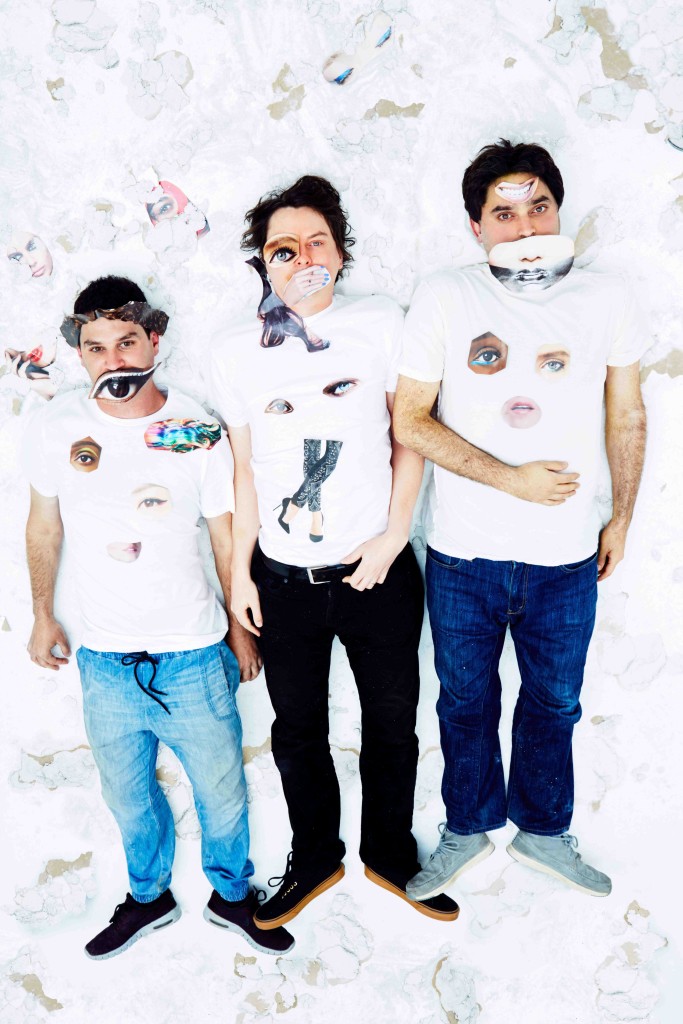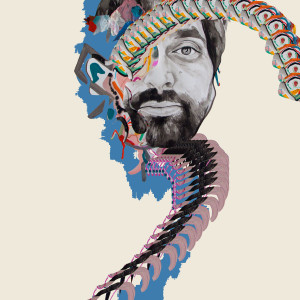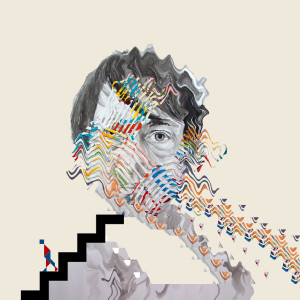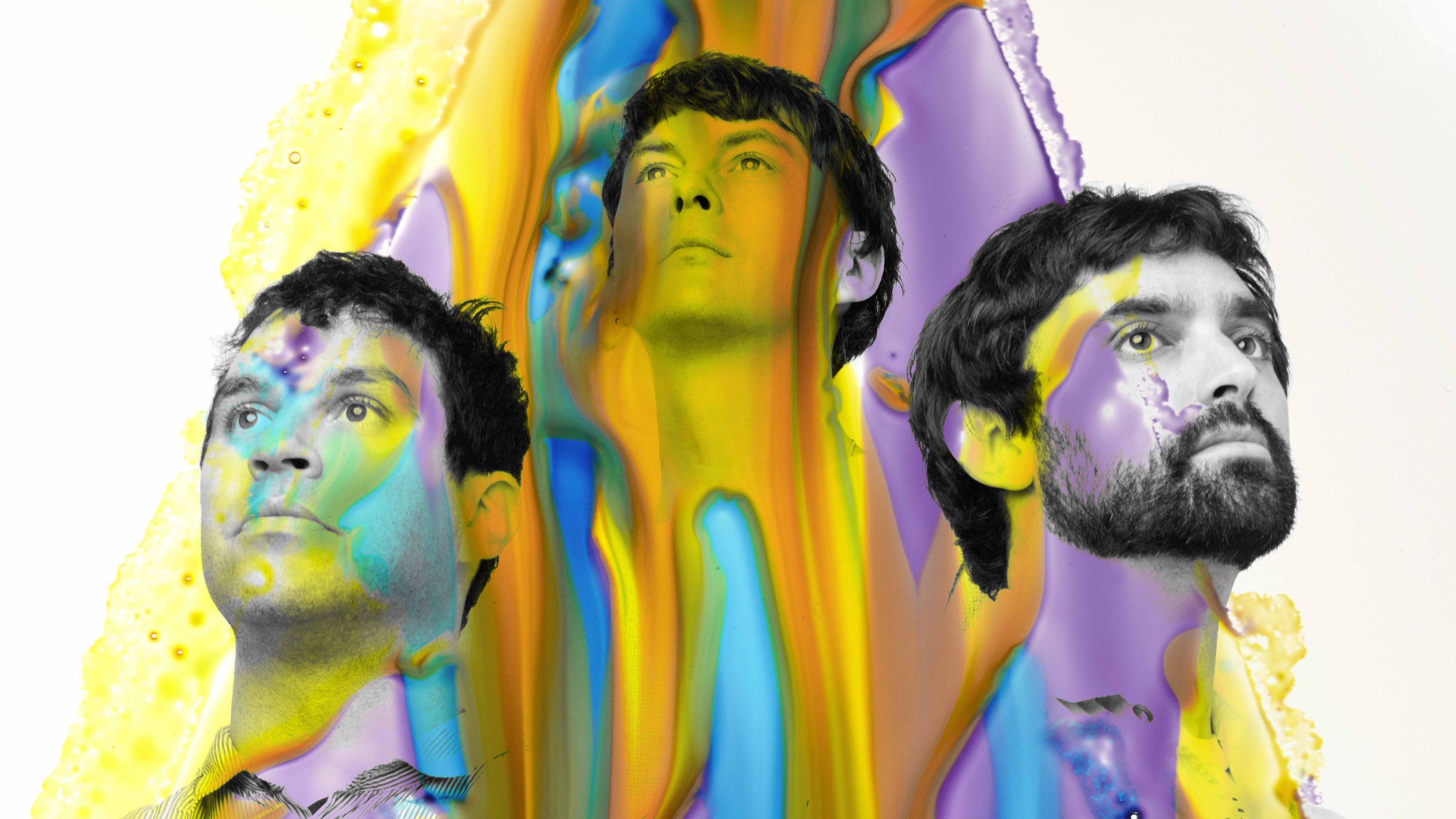In the simmering primordial soup of the Florida Everglades, creatures go about their daily routine, come what may. Frogs chirp arrhythmically. Insects intersect. Ominously scanning sets of eyes emerge with sudden gulps from beneath the watershed’s threshold. Not so far, far away, beyond the gates of Disney World, pinwheels turn and the children’s imaginations are still flush with hope and sweet possibility. In the rush of Los Angeles traffic, Dave Portner (a.k.a. Avey Tare) sits, listening to morning talk radio. The show’s hosts are carelessly lampooning people from the state of Florida. It is a bummer.
“Let’s talk about the dumb things people are doing in Florida right now,” Portner recounts months later in conversation at Brooklyn’s Converse Rubber Tracks studio, where he’s joined by bandmates Noah Lennox (Panda Bear) and Brian Weitz (Geologist). “I just thought it was really negative,” he says. “It really annoyed me that morning—why Florida, people from Florida in particular, over anybody?” Incited by the closed-mindedness of the program, Portner began to formulate what would become “FloriDada,” the lead single from Animal Collective’s eleventh album, Painting With. It’s not about the Sunshine State, exactly, but about a state of mind where people are organized according to less restrictive associations than those promoted by geographical stereotypes.
“Well, I love Florida,” Portner says. “I think people tend to, at first glance or first listen, think [“FloriDada”] is a song about Florida, which it is in one way, but it’s about more than that. [It’s] more about everything being like one place, instead of separate.” He is wearing a sweatshirt swamped with hundreds of versions of Mickey Mouse, all bearing different expressions that run the gamut of attitudes and emotions. Painting With came together in a way not unlike the nostalgic disorientation of his shirt. “In the sense of collage, it would be cool to write a song that was more about a different way of putting people together in a state or country,” he says. “I kind of thought of The Beatles’ ‘Back in the U.S.S.R.,’ or Beach Boys songs where they talk about all of the different places. ‘Surfin’ Safari’ or something, but make it kind of different.”
Collage is just one of the ways in which the “FloriDada” title’s latter half, inspired by the early-twentieth-century Dada art movement of the European avant-garde, came into conceptual play on Painting With.
“We’ve always been interested in collage stuff, musically—like musique concrète or electroacoustic stuff—so that comes up for every record,” says Weitz from the far corner of the room. “But this was the first one—since visual art and painting was coming up as well in our discussions—[where] the idea of Dadaism and its use of collage was more direct than the musical references to collage.”
“Or taking ordinary things and then making [them into] something else,” adds Portner.
“Alternate perspectives is a theme, I would say it’s safe to say,” says Lennox, who is quiet but confident, sitting on a comfortable-looking couch.

photo by Akira Bharoocha / Abby Portner
While these concepts are audible and resonant on the album, to lean too heavily on art-history reference points or philosophical concerns when confronting Painting With would be to sell the music short. “FloriDada,” which wouldn’t be out of place in a lysergic orange-juice advertisement, builds around a tribal percussion pattern that is uncannily evocative of “Grass,” a highlight from the band’s 2005 album, Feels. Before long, a squelching modular synthesizer, polyrhythmic layers of percussion, and dexterously arranged, upbeat vocal harmonies populate bright aural environs that, although unlike anything we have heard from the band to date, are nevertheless decidedly Animal Collective.
If there is any Painting With element that best embodies the band’s current evolutionary stage, then it is the carnival of exacting, almost neo-baroque vocal arrangements, which are executed to impressive result by Portner and Lennox. Harmonies sprawl with unrelenting vitality over the record’s twelve tracks, echoing and engaging in counterpoint exchanges at times by the syllable.
“Trying to do something special with vocals was definitely a target,” Lennox says.
“It’s the first time we ever wrote parts for each other,” Portner adds. “We wanted to confuse people as to who the lead vocalist was, or who even wrote the song, maybe. So it was done with that in mind, too, [which meant] having the vocals feel very snaky and intertwined, where they wrap around each other and come back around so you lose who was singing which part.”
The video for “FloriDada,” an inspired psychedelic clip from the Adult Swim brain trust PFFR, issues a seizure disclaimer to viewers before the visuals kick in. Were there such a thing as an auditory seizure warning, one would likely apply to the next song on the record, “Hocus Pocus,” which epitomizes the snaky, intertwined vocal approach that Portner describes. His and Lennox’s voices are like two heads of a hydra rising from the amniotic bog, darting and coiling with each other in able precision, charmed as they are by Weitz’s mad conjurer (headlamp on!).
It is a sound that mirrors the double-helical marriages of electric and acoustic, of primal and futuristic, all of which is deeply embedded into the Animal Collective DNA. As with much of Painting With, it feels like a dense evolution of its sonic forebears; appropriately enough, “Hocus Pocus” also features the chance appointment of none other than John Cale.
 “We needed a sample replaced, essentially,” Weitz explains. “A droney string thing. We liked the part, but the sound quality of it we didn’t totally agree on, and we felt like [we should] try it with a live instrument.”
“We needed a sample replaced, essentially,” Weitz explains. “A droney string thing. We liked the part, but the sound quality of it we didn’t totally agree on, and we felt like [we should] try it with a live instrument.”
“Dave’s sister [visual artist Abby Portner] has been working for John [Cale] doing visual stuff for performances, so we had a way to get to him,” Lennox continues, before Portner chimes in.
“[Abby] found out that we were a favorite contemporary band of his,” he says. “She told us that and we were like, ‘That’s sweet!’ We like a lot of stuff that he’s produced and worked on, so we thought we’d just try it out.”
Fortunately, all parties involved also happened to be (to borrow a term Portner would apply to the compatriot Ariel Pink camp) “big music heads,” and the band spent much of their John Cale session “geeking out over modular synths and drum stuff with him,” according to Portner. We talk about their favorite Cale work. Lennox prefers The Velvet Underground & Nico, featuring Andy Warhol’s trademark banana. Weitz, the record-head, cites Church of Anthrax, Cale’s collaboration with experimental composer Terry Riley. Portner has a harder time choosing just one project. He mentions Cale’s production work, including Nico’s The Marble Index, the first Stooges record, and early demos by The Police.
 Lennox perks up at this final inclusion. “Did he do Police demos? I didn’t know that,” he admits. “God, I wish I’d have talked to him about that.”
Lennox perks up at this final inclusion. “Did he do Police demos? I didn’t know that,” he admits. “God, I wish I’d have talked to him about that.”
“I don’t trust blonde bands,” Weitz says, imitating Cale.
Recorded at Los Angeles’ EastWest Studios—which has over time absorbed music from The Beach Boys, Frank Sinatra, and Marvin Gaye, among many others—the Painting With sessions were originally intended to take place in London, before scheduling conflicts moved the operation to Paris’ Gang Studios. Further time-related complications ensued, and in what Lennox refers to as a “buzzer beater,” recording ended up roughly in Portner’s LA backyard.
Arriving at EastWest to discover that the house instrumentation consisted of “a piano,” Portner tracked down an obscure percussion rental service, and with that Animal Collective began to establish its latest habitat.
 “We always want to make it our own kind of environment,” Portner says. “Studios can often feel like a sterile room, and if we’re going to be there a month, we don’t want to necessarily feel that we’re going to an office or something.” So they brought in a baby pool.
“We always want to make it our own kind of environment,” Portner says. “Studios can often feel like a sterile room, and if we’re going to be there a month, we don’t want to necessarily feel that we’re going to an office or something.” So they brought in a baby pool.
“We brought that in just to get all of the elements in there,” Portner says. “We filled it up with water, and we had fire, like candles, and did all this stuff. But then we ended up finding that it actually sounded cool.”
“It made you appreciate the value of a really cleverly engineered music space,” Lennox says of the studio.
“And the echo chambers were awesome,” Weitz adds.
Sister Abby came through in the clutch again by contributing a looping reel of dinosaur cinema.
“A lot of the sounds brought to mind prehistoric jungles and landscapes,” Portner says. “We’d talk about the dinosaurs. We’re always having visual reference points, just because it’s the way we’re comfortable working. Inevitably some images will be conjured here and there: dinosaurs and prehistoric cavemen. Squishing paint out of a bottle or something.”
Embossed behind the vivid, surreal imagery swirling in the minds of Painting With’s creators is something less immediate about Animal Collective, something weightier. Lennox references the subject matter of “The Burglars,” another standout track.
“I feel like in a lot of the songs there’s a theme. How there’s stuff inside of not just human beings, but in all creatures. Stuff that’s there naturally in order to bring about good things, but how often that can sort of bear sour fruit.” — Noah Lennox
“I always saw it as the survival instinct and how that plays out in dark ways,” he says. “Everybody’s out for themselves and trying to get theirs.”
“And is that inherently a bad thing?” Portner responds.
“I feel like in a lot of the songs there’s a theme—this is the first time I’m putting this together,” Lennox says. “How there’s stuff inside of not just human beings, but in all creatures. Stuff that’s there naturally in order to bring about good things, but how often that can sort of bear sour fruit.”
I ask whether the experience of being in Animal Collective has ever borne any sour fruit. Lennox, Portner, and Weitz take a moment to consider the question, but find that they haven’t very much to complain about.
“Sometimes you have to remind yourself, I think we have it pretty good,” Portner says. “We get along with each other—for decades at this point. This is how we make our well-being, but it also started initially as a fun project, us enjoying making music with each other.”
In Florida, the sun shines. FL









